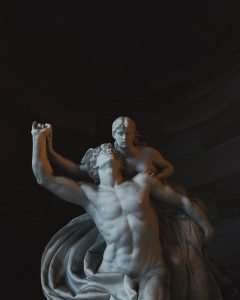“The Vikings” are a group of Scandinavian seafarers who raided, traded and explored much of the world from about 793 to 1066 A.D. During their lifetime, they were better known as “Northmen” or “Norse,” but over time they have become associated with the Viking ships they sailed and the art they produced while they traveled.
This blog is intended to be a resource for anyone interested in this fascinating topic, whether you’re a student trying to find sources for a paper, or an enthusiast who has always wanted to know more about Norse art. The posts on this blog cover many areas of interest, from the factual to the artistic and symbolic. You will learn about Viking life and culture, their ships, burial customs, jewelry and weapons. You will also see examples of their art and read commentary on it.
You will also see lots of images of Viking art which I hope will inspire you to search out museums which house original artifacts, or visit sites where you can see replicas like those made by The Jorvik Viking Centre in York England. And if you are inspired to make your own replica artifacts, please contact me with pictures so that I can share them here!
Finally, this blog is not intended as a highbrow review
Welcome to the Viking Art blog. The blog is devoted entirely to the art of the Vikings and its study.
Viking art refers to the artwork created by the Norse people, who settled in Scandinavia as well as other regions during the Viking Age (793-1066 CE). Their art is typically characterized by animal ornamentation, extensive use of intricate patterns and stylized depictions of people and mythical creatures.
The purpose of this blog is to provide a central resource for those interested in learning more about Viking art, from those with a general interest in history and culture to academic researchers. It will contain information about exhibitions, publications, conferences, museums and other institutions that foster knowledge about Viking art; news related to research on Viking art; and updates on my own research into this subject.
This blog was established on March 27th, 2010. I will update it regularly with new posts regarding developments in my research, information about new exhibitions or publications related to Viking art, conference announcements, and more. If you would like to be notified when new posts are published here, please subscribe via RSS feed or e-mail by using the subscription box at the right side of this page.———-
On this site, you will find a wealth of information related to Viking art. The Viking age refers to the period between the late 8th century and the mid 11th century. This period was hard on the Scandinavians as it saw them experience political and societal changes.
The years 870-930 were marked by raids, conquests and settlements in mainland Europe by the Norsemen. This led to the creation of kingdoms in Ireland, Scotland, England and Normandy, which were ruled by Danes and Norwegians.
You can read more about Viking art here.
Viking art is a relatively new area of interest for me. It was first brought to my attention by an exhibit at the British Museum, and then I was introduced to the work of Dr. Judith Jesch (University of Nottingham). As a medievalist myself, I’ve become increasingly interested in the Viking Age and its impact on our medieval heritage.
Týr and Böðvar are two of the most fascinating characters from Norse mythology, and their stories are well worth exploring. In this blog post I will focus on their depictions in art and literature and their influence on later depictions of heroes.
Viking warrior god Týr
The earliest known depiction of Týr comes from a Swedish stone carving from the 8 th century, which depicts a figure riding a horse with his sword drawn. His hand is outstretched as if he’s either calling on his power or as if he’s about to strike with his sword. There are also some very interesting figures that resemble Týr that appear in some Norwegian tapestries from around the same time period.
These tapestries depict people carrying shields into battle and feature figures standing outside the shields holding swords and spears out towards enemies. These figures look very similar to depictions of Tý
In the late 1860’s and early 1870’s, a large number of Viking Age artifacts were found in a small area of … In the late 1860’s and early 1870’s, a large number of Viking Age artifacts were found in a small area of … In the late 1860’s and early 1870’s, a large number of Viking Age artifacts were found in a small area of …
In the late 1860’s and early 1870’s, a large number of Viking Age artifacts were found in a small area of Denmark. The items included ornate broaches and weaponry, as well as fragments of intricately carved wooden objects. Among these fragments was one that held particular interest for archaeologists: an elaborate carved panel depicting the crucifixion of Christ. This panel is currently on display at the National Museum of Denmark in Copenhagen. It is one of only three known panels from its period depicting iconography from northern Europe; the other two are on display at museums in Oslo and Bergen, Norway.
The style and subject matter of this piece place it squarely within the art tradition created during the time known as the Late Antique North Atlantic Period, which lasted from approximately A.D. 800 to 1100. This period is also commonly called Norse Medieval Art (NMA), characterized by strong characteristic animal decoration
The Vikings were the Scandinavian seafarers who plundered Europe from the late eighth to the mid-11th centuries, mostly by raiding its coasts. During that time, they travelled far beyond the shores of Scandinavia and Russia, reaching Iceland, Greenland and North America. The Vikings were great travellers but also conquerors and settlers; they settled in Scotland, Ireland, France and England.
The term Viking was first applied by their victims in the British Isles, who used it to describe the raiders as a collective noun meaning “pirate” or “raider”. Over time, however, the word came to be associated with Scandinavian seafaring in general due to its connotations of violence and fear. In modern-day Scandinavia it is occasionally used as a derogatory term for Swedes. http://www.historyofwar.org/articles/weapons_vikings1.html


